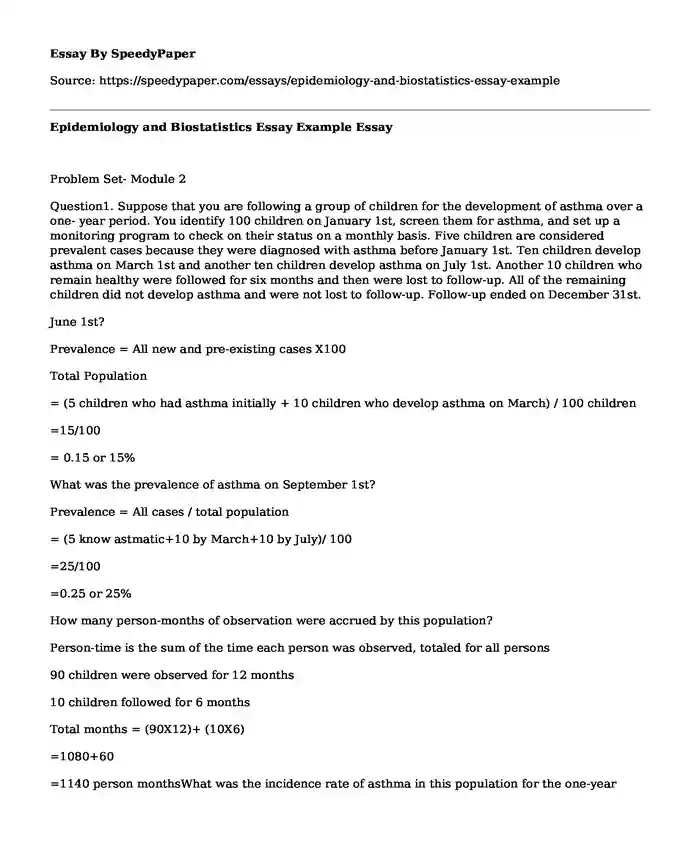Problem Set- Module 2
Question1. Suppose that you are following a group of children for the development of asthma over a one- year period. You identify 100 children on January 1st, screen them for asthma, and set up a monitoring program to check on their status on a monthly basis. Five children are considered prevalent cases because they were diagnosed with asthma before January 1st. Ten children develop asthma on March 1st and another ten children develop asthma on July 1st. Another 10 children who remain healthy were followed for six months and then were lost to follow-up. All of the remaining children did not develop asthma and were not lost to follow-up. Follow-up ended on December 31st.
June 1st?
Prevalence = All new and pre-existing cases X100
Total Population
= (5 children who had asthma initially + 10 children who develop asthma on March) / 100 children
=15/100
= 0.15 or 15%
What was the prevalence of asthma on September 1st?
Prevalence = All cases / total population
= (5 know astmatic+10 by March+10 by July)/ 100
=25/100
=0.25 or 25%
How many person-months of observation were accrued by this population?
Person-time is the sum of the time each person was observed, totaled for all persons
90 children were observed for 12 months
10 children followed for 6 months
Total months = (90X12)+ (10X6)
=1080+60
=1140 person monthsWhat was the incidence rate of asthma in this population for the one-year period?
Incidence rate = total number of subjects becoming case / total person months
=20/1140
=0.01754 cases per persons-month
= 17.5 cases per 1000 person months
Question 2 Consider a group of 1,000 newborn infants. 100 infants were born with serious birth defects and 20 of these 100 died during the first year of life. 90 of the 900 remaining infants without any birth defects also died during the first year of life.
Calculate the prevalence of serious defects in this population at the time of birth.
Prevalence = Total cases / Total population
= 100/1000
= 0.1 or 10%
Calculate the overall cumulative incidence of mortality in this population.
Cumulative incidence = Total deaths / Total population
= (20+90) / 1000
= 110/1000
= 0.11 or 11%
Calculate the cumulative incidence difference in mortality between infants born with serious birth defects and without.
Infants born with serious birth effects = 100 there incidence is 100/1000 =0.1
Infants born without serious birth effects = 900; there incidence is 900/1000 =0.9
The difference = 0.9-0.1
= 0.8%
State in words your interpretation of the cumulative incidence difference calculated in part c.
There is a risk difference of 0.8% which is the difference between the rate of children with birth defects and those with n effects
Question3. How does each of the following conditions influence the prevalence of a disease in a population? For each scenario, assume that no other changes occur. Your choices are: increases prevalence, decreases prevalence, or has no effect on prevalence.
A treatment is developed that prolongs the life of people suffering from the disease
Has no effect on prevalence
A new measure is developed that prevents new cases of disease from occurring
Decrease the prevalence
There is immigration of a large number of healthy people into the population.
Decrease the prevalence
The case-fatality rate for the disease increases
Has no effect on prevalence
Reference
Merrill, R. M. (2013). Fundamentals of epidemiology and biostatistics: Combining the basics. Burlington, MA: Jones & Bartlett Learning.
Cite this page
Epidemiology and Biostatistics Essay Example. (2022, Apr 07). Retrieved from https://speedypaper.net/essays/epidemiology-and-biostatistics-essay-example
Request Removal
If you are the original author of this essay and no longer wish to have it published on the SpeedyPaper website, please click below to request its removal:
- Free Essay on Steps to Solving a Problem
- Free Essay on a Child With Learning Disability
- Free Essay Example on Business Politics
- Building a Team, Free Essay in Conflict Management
- Essay Example about Cross-Cultural Healthcare Reforms
- Paper Sample on Sexual Harassment: Violence Against Women Working in Silicon Valley
- Essay Example on Management of Diabetes
Popular categories





